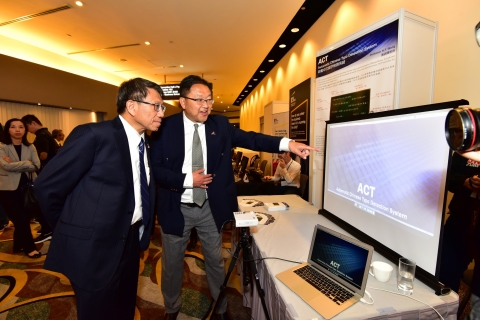The Centre for Innovation and Technology (CINTEC), Faculty of Engineering, The Chinese University of Hong Kong (CUHK) held a technology forum titled ‘Artificial Intelligence (AI) Over Humans?’ today (18 January 2018), drawing over 500 technology leaders, experts, researchers and government officials to discuss the future possibilities and development trends of AI and explore more potential opportunities. The forum was officiated at by Mr. Nicholas W. YANG, Secretary for Innovation and Technology, the HKSAR Government and Prof. Rocky S. TUAN, Vice-Chancellor and President of CUHK, and chaired by Prof. WONG Kam Fai, Associate Dean (External Affairs) of the Faculty of Engineering and Director of CINTEC, CUHK. The main speakers from CUHK were Prof. Sean TANG Xiaoou, Professor, Department of Information Engineering and Founder of SenseTime Group, Prof. Irwin KING Kuo Chin, Associate Dean (Education) of the Faculty of Engineering and Professor, Department of Computer Science and Engineering, Prof. Raymond TONG Kai Yu, Chairman, Department of Biomedical Engineering, Prof. Max MENG Qing Hu, Chairman, Department of Electronic Engineering, Prof. Samuel AU Kwok Wai, Associate Professor, Department of Mechanical and Automation Engineering, Prof. LIN Dahua, Assistant Professor, Department of Information Engineering, and Prof. Helen MENG Mei Ling, Chairperson, Department of Systems Engineering and Engineering Management. Other guest speakers included Mr. Benson NG, Partner and EY Greater China Digital Advisory Leader, Ernst & Young Advisory Services Ltd., and Mr. Nelson CHOW, Director, Advisory Services, EY Greater China. They spoke about their insights into applications of AI in computer science, surgeon and robot, healthcare for prevention and treatment and patient outcomes, the video and media world, and financial technology. In addition, a number of AI projects were showcased at the forum. In the forum, Prof. Rocky S. TUAN, Vice-Chancellor and President of CUHK said, “With the omnipresence and power of AI clearly in sight and within our reach, how should humans co-exist and manage this new “being” as a benevolent partner? This is particularly relevant to Hong Kong as it is actively striving for the advancement of Innovation and Technology, particularly in its efforts to lead the development of the Greater Bay Area.” Prof. WONG Kam Fai said, “AI has always been one of the key research areas of our Faculty. For example, back in 1998, our research in Natural Language Processing has established the first electronic Chinese newspaper company Wisers whose AI services are now widely used by the media. For another example, recently, Imsight Medical, a start-up supported by the Faculty, has developed a rapid and accurate system of automated medical image analysis for early lung and breast cancer diagnosis and monitoring in the medical community.” CUHK has been well recognised internationally for its excellence in AI research. The University strives to innovate and apply AI technology in more areas in the future, for example, in medical imaging analysis, computational photography and vision, biomedical devices, and speech recognition and text-to-speech technology. Many of the University’s innovations in AI have been successfully transferred and commercialised to benefit mankind. Early in 2011, Prof. Sean TANG Xiaoou’s research group built a novel facial recognition system with the highest accuracy in the world. That was the first time for computing algorithms to reach human face verification performance on this dataset. CUHK Multimedia Lab was named as one of the world’s pioneers in AI research in the 2016 GPU (graphics processing unit) Technology Conference, Silicon Valley.
|
|




